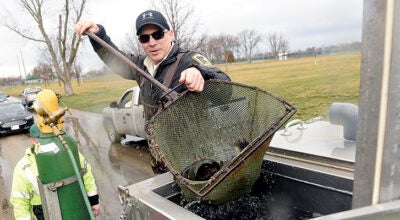Out for the count
Published 10:51 am Saturday, May 8, 2010
Though a recent audit blames glitches in Census computer systems for driving up costs and risking the accuracy of the count of the decade, operations are reported to be running smoothly out of Rochester — which is managing census efforts in Mower County and 12 other southern Minnesota counties.
The population count, conducted every 10 years, is used to distribute House seats and more than $400 billion in federal aid; and though mail-in forms were due in April, door-to-door surveying kicked off this month and will continue through July, according to the bureau.
A report from the Commerce Department inspector general’s office was obtained Wednesday by The Associated Press, offering details on the scope of computer problems as more than 600,000 census workers began fanning neighborhoods this month to conduct interviews at 48 million homes.
Candace Gordon is the local census office manager in Rochester, and she said despite reported frequent outages in the bureau’s computer systems, local efforts are on track.
“Our people are all busy and are out working as planned,” she said.
Door-to-door work
Of the 132 million households nationwide contacted through mail by the Census Bureau, about 72 percent returned completed questionnaires before door-to-door work began.
In Minnesota, the rate of return was 80 percent (No. 2 nationally, after Wisconsin’s 81 percent) when at least 8,000 enumerators were pegged to begin canvassing across the state — up to 70 of them in Mower County.
More than 250 candidates applied for the full-time temporary jobs with the census’s Mower County enumeration project.
The work can last anywhere from two weeks to three months for each individual; and as the workers, the majority of whom were unemployed prior, find long-term employment, turn-over means the Rochester office pulls in new enumerators from their original field of applicants, Gordon said.
“It’s the nature of it… It’s temporary work so some people are looking for something more stable,” Gordon said.
Even when going as planned, census work can be difficult.
Enumerators receive a binder after they complete training which contains a list of all of the homes they are to visit. Next, they try to track down the residents who have not sent in their census forms — visiting homes up to three times, and telephoning three additional times.
All census takers carry an ID badge with a Department of Commerce watermark, and local residents can call the bureau at (507) 206-5050 to confirm that their visitor is in fact a registered government employee.
Though it can be tricky to track down people, Gordon, who works in the office, said many find it fulfilling to make sure everyone is counted.
What’s at stake
In Minnesota, failure to account for as few as 1,000 people could mean the surrender of the eighth congressional seat.
Locally, in the county and the city of Austin, population numbers will determine federal aid — for things like roads, schools and medical facilities — which is why a Complete Count Committee was formed to publicize the census early, Austin Mayor Tom Stiehm said.
Eighty percent of Austin and of Mower County households mailed back their census forms by the April deadline.
“Now, our work is over, and it is up to the census employees to try to count everyone,” Stiehm said. “We did our best to make sure traditionally underrepresented groups… college students, snowbirds, immigrants, illegal immigrants too, would participate.”
Dora Martinez, a care advocate and program coordinator at Austin’s Welcome Center Inc., said in March that volunteers braved rainy weather going door to door to almost 100 residences in Austin promoting census participation.
In addition, the Mower County Senior Center, Austin Public Library, Queen of Angels Church, Austin Packaging and Quality Pork Processors Inc. all held workshops to help people fill out the census.
Nationally, there have been public service announcements by the children of Martin Luther King, Jr. and Coretta Scott King, President Obama, Miss America Caressa Cameron, Donny Osmond, Karl Rove, Olympic athletes, major league baseball players and other public figures encouraging people to open their doors to census takers.
Census glitch
Unlike the 2000 census, in which some residents received a short form while others got a 53-question form, the 2010 census has the same 10 questions for everyone. Questions include name, age, birth date, race and gender. The form also asks whether occupants rent or own.
The audit report from the Commerce Department inspector general’s office said major outages in the computer system used to manage that information caused a 40-hour backlog of work over two weeks in April.
This caused substantial amounts of overtime and other workarounds, according to the report.
Overtime costs have reached more than $1.6 million, with costs expected to grow higher, due to the workload now required in door-to-door canvassing — potentially breaking the Census Bureau’s $15 billion budget.
“If performance problems persist, they will put the successful completion (of the census) at risk,” the report states, in urging the Census Bureau to add staff and implement more checks to make certain census forms are not lost.
Gordon said because this is not influencing the Rochester office, they will not need to add unplanned staff.
The Rochester office is currently hiring clerks, who live in the Rochester-area. Interested candidates can call (507) 260-5050.
In a news briefing this week, Census Bureau director Robert Groves predicted that the additional costs for staffing will not cause the bureau to exceed its budget for the 2010 count.
The computer problems are a result of hasty design to the bureau’s Paper Based Operations Control System that began in early 2008, after the Census Bureau nixed plans to use a handheld-computer method that ended up costing more than $700 million but did not operate adequately.
Other findings in the report describe the bureau’s monthly spending reports as somewhat unreliable, with actual costs exceeding the operating budget by as much as 7 percent. It also suggests that census takers have met difficulties with assignments due to faulty maps, overstaffing and inefficient coordination.
Gordon said census takers are completing tasks as scheduled in Mower County and the southern Minnesota region.
For more information about the census, go to 2010.census.gov.
— The Associated Press contributed to this report.



